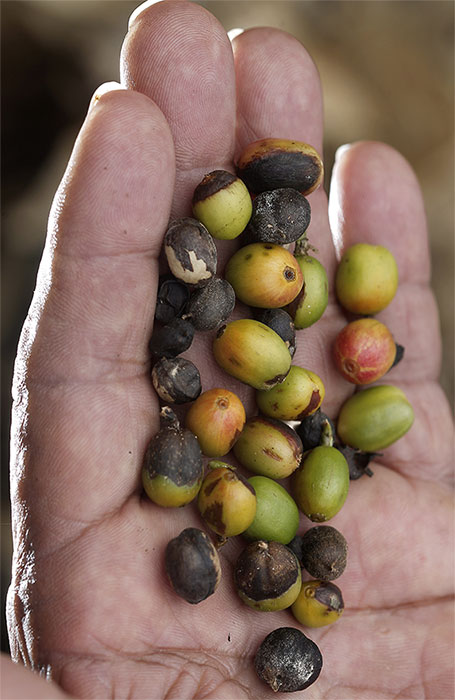The "Coffee Rust": The coffee producers nightmare that set the course of coffee

The coffee we drink today has reached the brink of extinction, from a dangerous fungus.
Enjoying our coffee, we often tend to forget that it is a natural product that grows in plantations in tropical climates. Like any naturally grown crop, coffee has its own environmental footprint, but also its own threats, such as weeds, diseases and insects.
However, the main threat of coffee has largely defined its history, but also (to a certain extent) the history of mankind, and due to climate change, it is certain that it will concern us even more in the future. The reason for the infamous "Coffee Rust", the largest coffee's threat, is nothing more than a highly contagious and dangerous fungus.
What is Coffee Rust?
The scientific name of the fungus is Hemileia vastarix, while "coffee leaf rust" is the disease that causes. The fungus is a parasite, while the coffee plant is the host that "hosts" it to survive and reproduce. For the time being, no effective cure has been found for Rust, and coffee growers are trying to cope with plant mating in order to end up with hybrids that are more resistant to the spread of the fungus but also to its disastrous effects on its plants.
The treatment is made even more difficult by the fact that the climatic conditions necessary for the growth of the coffee trees are exactly what the fungus prefers for their spreading; are considered less durable.
The fungus is perceived as yellow or brown spots on the leaves of plants, reminiscent of oxidized iron - and if left untreated, the plant will soon be dried and destroyed as the fungus searches for new host trees.
 Where it originates from and how wide its spread is?
Where it originates from and how wide its spread is?
The roots of the Coffee Leaf Rust fungus are found in East Africa, with the first recorded case being recorded in Kenya in 1860, although its most likely origin is the highlands of Ethiopia and Sudan. However, its lightning strike spread to Asian territory. In the late 19th century, the fungus reached Sri Lanka, Indonesia and India, where it spread rapidly from one end to the other, and by the mid-20th century, it had spread throughout the African continent. It first arrived in Brazil in the 1970s, and by 2010 scientists have announced that it is now endemic to almost all countries of the "coffee belt", having now been found all over the world.
Its rapid spread is due to the fact that fungal seeds are propagated in many ways, such as by air, rain, animals and humans, and have proved to be highly resistant to transatlantic travel.
How did the rust fungus affect the coffee world?
The fungus of coffee rust is one of the main reasons for the decline and rise in coffee prices worldwide, depending on the disasters that occur every year on the plantations since its expansion. However, over time, it has had even more significant effects.
The first wave of fungi that struck Southeast Asia in the 19th century almost destroyed all Asian coffee plantations, culminating in the production of Sri Lanka, which was completely destroyed and never recovered. Many countries had to change crops, so Sri Lanka turned to tea, with particular success. Historians say that if it had not been for the fungus, the Britons would probably have been fanatical coffee lovers, since colonial Ceylon was their main supplier of coffee - and later, tea, which developed into national fury.
Still, rust fungus is one of the main reasons for the spread of Robusta coffee. Robusta, though bitter and with less flavour, is more resistant to fungi, and has been chosen by many countries as an alternative. Vietnam, the world's largest producer of Robusta, might not have turned to this crop if the fungus had not threatened. The consolidation of Robusta as an alternative has shaped the global coffee culture, evolving the blending and espresso flavor.
Experts warn that climate change will exacerbate the situation, with the worldwide spread of fungi causing concern in the coffee world. However, today we are definitely more and better equipped to deal with threats from colonial Ceylon - and we hope to continue enjoying our beloved Arabica for many more years!










